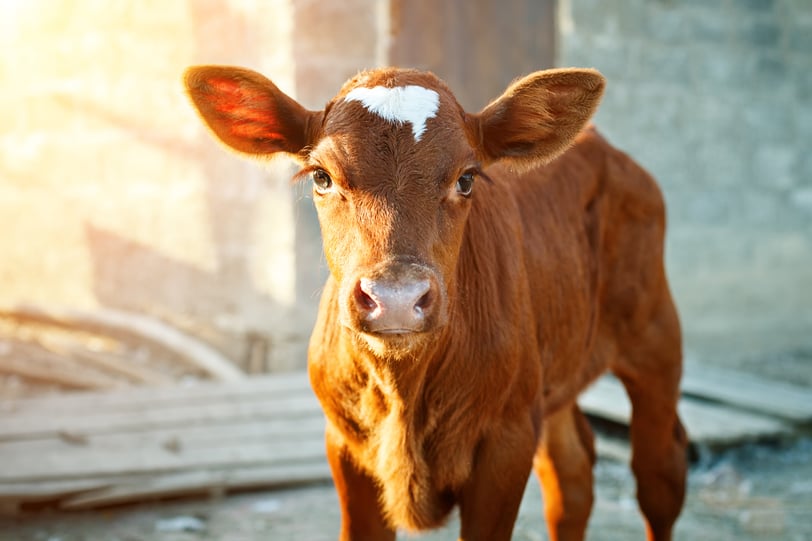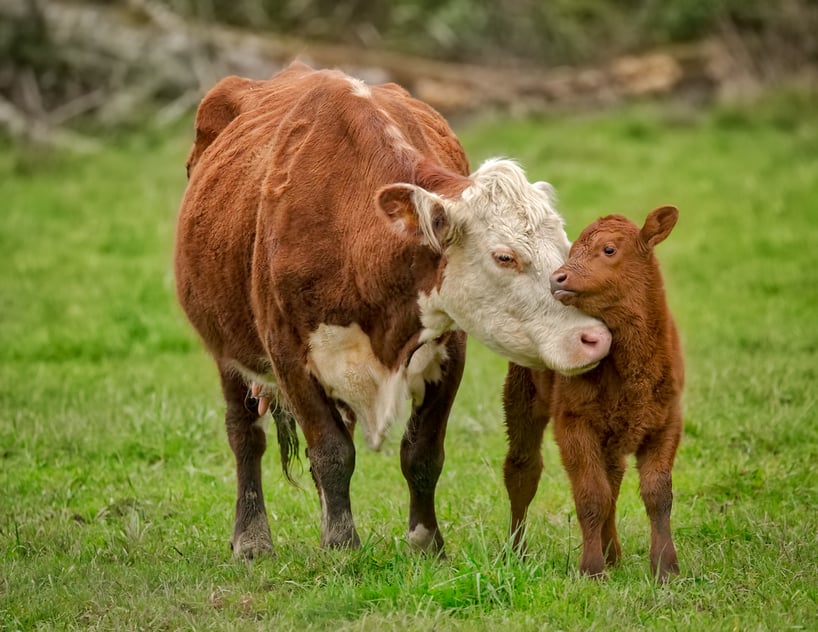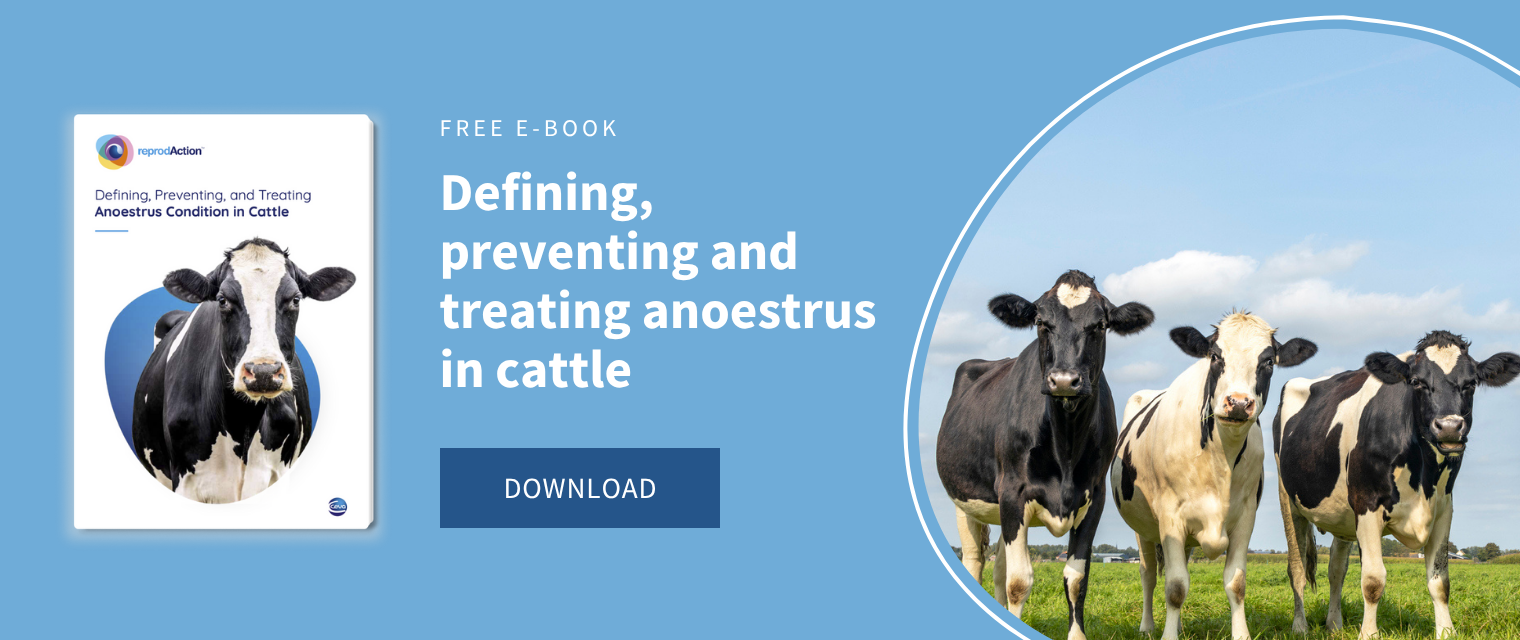Reproduction stands as the cornerstone of profitability in beef cow-calf operations, exerting a big economic impact. Surprisingly, many producers overlook its significance. This article explores why reproduction is paramount and outlines crucial strategies for maximizing reproductive efficiency in beef herds.
Prefer to listen to this article? Click the play button below and enjoy our podcast!
Why is reproduction so key for cow-calf operations
In beef cow herds, pregnancy has a four-times greater economic impact than any other production trait; yet how many producers select for pregnancy first? This conclusion comes from a series of studies conducted in the United States by the Beef Reproduction Task Force, but very similar deduction could be drawn from an analysis of the European and other markets beef industry.
To further emphasize this notion, it is worth remembering that, in contrast to the dairy industry where milk is the major output, the only economic output of a suckled beef cow, apart from her cull cow value, is a weaned calf.
The economic success of beef cow-calf operations relies on the ability to produce one live healthy and heavy at weaning calf per cow and bred heifer every year.
The main reproductive targets for a beef cow herd are:
- 365 days calving to-calving interval,
- Having less than 5% cows culled annually due to lack of pregnancy,
- ≥ 95% of cows calving to wean a calf,
- heifers calving for the first time at 24 months of age,
- compact calving with 80% of cows calved in 6 weeks,
- replacement rate 16% to 18%.
To achieve these industry goals, 4 main reproductive events need to be accomplished:
- Puberty in heifers needs to occur around 1 year of age,
- Estrous cyclicity needs to be resumed soon after calving (< 60 days),
- Estrus should be expressed and detected (when relying on artificial insemination AI),
- Pregnancy established in a timely fashion to allow compact calving.
Defining and characterizing puberty in heifers
Puberty is the developmental stage that supports normal ovarian cyclicity combined with the ability to sustain a pregnancy. The critical factor for the achievement of puberty is the release of a sufficient amplitude of gonadotropin releasing hormone (GnRH) from the hypothalamus which can induce a peak of LH which can cause ovulation, followed by the formation of a corpus luteum (CL) which should have a lifespan sufficient to reach the timing of maternal recognition of pregnancy.
Puberty is attained when heifers reach a certain proportion of the mature body weight (MBW), which normally is between 55 and 60%, with a target for breeding at 65% MBW. There is an important genetic component into the timing of puberty; with continental beef breeds Charolaise, Limousin being later pubertal and so-called British breeds Angus and Herefords being precocious puberty breeds.
Resumption of ovarian cyclicity post-partum
After a normal calving about 30 days are necessary for the uterine health of the cow to be restored.
The resumption of the ovarian ability to ovulate is achieved, similarly to the reach of puberty, when a sufficient amount of GnRH pulses is released by the hypothalamus inducing a preovulatory LH surge. In the majority of beef cows, the LH storage in the anterior pituitary would be already sufficient at 30 days post-partum, but this storage is sequestrated by the inhibitory effect that the mother-calf bonding imposes on GnRH release. The time needed to revert this “GnRH blockage”, is influenced by the nutritional status (low body condition score and negative energy balance prolong the post-partum interval) and parity (first calvers have normally prolonged post-partum intervals due to the metabolic energy demand for growth).

Estrus expression
The detection of the standing behavior is the best indicator that a cow is in estrus and it is an accurate predictor of ovulation. The interval between the first and the last standing event is defined as length of the estrus phase, this varies quite significantly. Beef heifers have shown an average duration of 12 to 14h and beef cows, managed under confined conditions, have shown an interval of less than 8.5 h, with no diurnal or nocturnal pattern. The main factors impacting the rate of the expression and the consequent possibility of submission for insemination are: the size of the sexually active group (how many cows/heifers are in estrus or pro-estrus simultaneously) and the underfoot surface (pasture vs straw bedded areas vs concrete vs slats).
The importance of the correct timing for pregnancy establishment to ensure compact calving
For beef herds, calving time is set to match herd energy demand with pasture availability and quality. Alternatively, mean calving time could be set to capture certain economic reward linked with market opportunities.
Sufficient feed supply has strong association with maternal productivity; maintenance requirement and energy partitioning change dramatically when nutrients are necessary to support body functions such as lactation and reproduction. Cows that are calving at the best time of the spring season have the fastest recover of cyclicity, best chances of re-conception while they are weaning the heaviest calves. To allow the majority of cows to remain in this virtuous circle, a very strict policy on the length of the breeding season is necessary.
One way to optimize and simplify all these 4 important parameters is the use of fertility programs for timed artificial insemination; for more information on the topic, consult our article about Beef cow synchronization protocols.

The economical impact of infertility and subfertility of beef cows
When discussing infertility for a beef cow we intend the animals that fail to wean a calf. In this category fall all the animals that either did not conceive during the breeding season or even if got pregnant failed to wean a calf.
Carrying over these cows would mean, for the breeder, spending the full yearly cost of maintenance of these cows and losing the profit which should have been generated by the calf sale. An interesting economic analysis has been performed by the University of Florida in the US in recent years (Prevat et al., 2018), which have shown that, for every open cow that at the end of the breeding season farmers retain, there is a total cost to be adsorbed which varies between 700 to 1100 US$ (644-1012 €).
Making a simulation of a 100 cow herd, and assuming the infertility rate (% of open cows at the end of the season) varying from 4% to 12% the total costs linked with infertility for a beef farmer can range between 2800 US$/2580 € (in the case of 4% infertility and low annual costs of production 500 US$/460 €) up to 13’000 US$/12’000 € (in the case of 12% infertility and the highest costs of production 900 US$/828 € per year).
The same study evaluated the impact of subfertility. Considering sub fertile the cows which required the longest time to conceive (from 61 to 120 days of the breeding season in this example) these animals finished weaning a lighter calf having costed the same money for their maintenance and ultimately bringing an economical loss of 4700 US$/4300 € versus the cows that conceived in the first 60 days of the breeding season.
Conclusions
Reproductive success for the sustainability of beef cow herds is essential. The achievement of a compact calving ensures maximal pasture utilization and the best conversion of grass into milk for calves’ growth. To achieve a compact calving in the spring it is needed an early onset of puberty in heifers and a fast resumption of cyclicity in suckled cows.
Cows and heifers conceiving in the first half of the breeding season are far the most profitable, carrying open cows at the end of the breeding season can have a detrimental impact on revenue.
References
Diskin MG, Kenny DA. Managing the reproductive performance of beef cows. Theriogenology. 2016 Jul 1;86(1):379-87. https://www.doi.org/10.1016/j.theriogenology.2016.04.052.
Diskin MG, Kenny DA. Optimising reproductive performance of beef cows and replacement heifers. Animal. 2014 May;8 Suppl 1:27-39. https://www.doi.org/10.1017/S175173111400086X.
Prevatt C., Lamb CG., Dahlen C., Mercadante VTG., and Waters K. “What Is the Economic Impact of Infertility in Beef Cattle?” This document is AN208, one of a series of the Department of Animal Sciences, UF/IFAS Extension. September 2018
Randi, F., and P. Lonergan. "Beef cattle reproductive management." Veterinary Ireland Journal 9.6 (2019): 322-327.
About the author
Federico Randi (Ruminants Global Technical Manager)
Federico Randi is Global Technical Manager for Ruminants at Ceva Animal Health, specializing in cattle reproduction. With a Doctor of Veterinary Medicine degree “cum laude” from the University of Bologna, he focused his career on improving efficiency and sustainability of farmed animals. Randi conducts research on ruminants fertility, using technologies like Timed AI, embryo transfer, and recombinant technologies. His extensive experience includes collaborative projects with over 20 research institutions globally. He earned his PhD at University College Dublin, concentrating on fixed-time artificial insemination and embryonic maternal communication in cattle. Currently, he serves as a Board Member in the Scientific Commission of Animal Physiology for the European Federation of Animal Science (EAAP) as an Industry Representative.

.jpg)


Leave your comments here